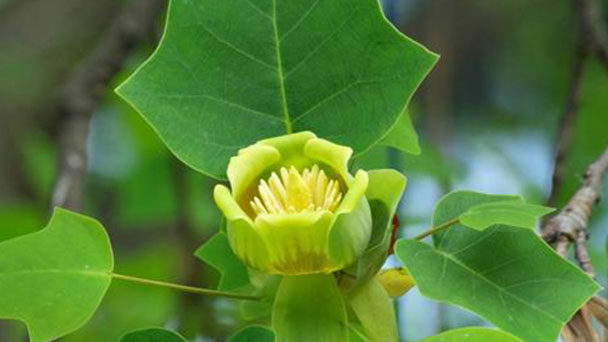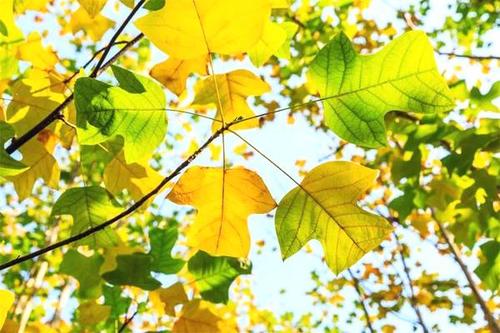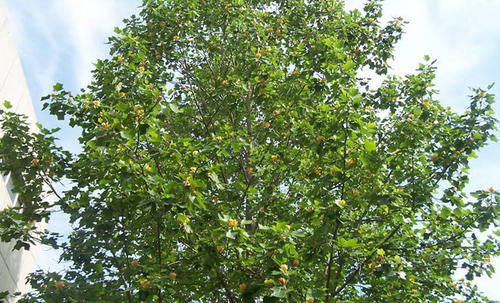Liriodendron Chinense (Chinese Tulip Tree) Profile
Written by Maggie
Oct 15 2021

Chinese tulip tree, scientific name Liriodendron chinense, grows fast, is drought-tolerant, and has strong resistance to pests and diseases. The flowers are big and beautiful, and the leaves are golden in autumn, like a yellow mandarin jacket. Liriodendron chinense is a precious street tree and garden ornamental tree, which can quickly form shade after planting. It is also a good wood for building and making furniture. It mainly grows in the south of the Yangtze River basin.The main treatment is rheumatism arthralgia, cold cough and other diseases.
Liriodendron Chinense Picture

Liriodendron Chinense Characteristics
Liriodendron chinense (Chinese tulip tree) is an arbor with a height of 40 meters and a diameter at breast height of more than 1 meter. Its twigs are gray or grayish brown. Leaves jargon-shaped, 4 -- 12 (18) cm long, with 1 lateral lobe on each side near base, apex 2-lobed, pale below, petiole 4 -- 8 (-16) cm long. Flowers are cup-shaped, tepals 9, outer wheels 3 green, calyx sheets, curved and pendent, inner wheels 6, erect, petal-shaped, obovate, 3 -- 4 cm long, green, with yellow longitudinal stripes, anthers 10 -- 16 mm long, filaments 5 -- 6 mm long, pistil beyond tepals at flowering, carpels yellow-green.
Liriodendron chinense tree aggregation 7-9 cm long, winged nutlets ca. 6 mm long, tip obtuse or obtuse, with 1-2 seeds.
The flowering period of Liriodendron chinense is in spring and the fruiting period is in autumn.
Liriodendron Chinense Native Habits
Liriodendron chinense (Chinese tulip tree) is fond of light, mild and humid climates, and has a certain cold tolerance. It likes deep, fertile, wet and well-drained acid or slightly acid soil (pH4.5-6.5). liriodendron chinense cannot grow well in arid land, and it also avoids low humidity and waterlogging.
Liriodendron chinense is usually born in mountain forests or forest margins at an altitude of 900-1 000 meters, with scattered distribution and small pure forests.
Liriodendron Chinense Propagation
Liriodendron Chinense Seed Propagation
Liriodendron chinense propagates from seeds and must be artificially pollinated. After selecting seeds in autumn, they accumulate in the middle layer of wet sand for winter, and sow and raise seedlings in the next spring. The third year seedling height of 1 meters or more time can be out of the nursery planting. The root should be protected when grafting. Cultivated soil with a deep, fertile, well drained acid and slightly acid soil.
Liriodendron Chinense Cutting propagation
In addition to sowing seedlings, Liriodendron chinense (Chinese tulip tree) can also be used to raise seedlings by cutting. In the southern area of Henan Province, a hard cutting method is used, and its seedling raising method is simple and easy to learn. In the second half of February after deciduous, the choice of robust mother tree, cut annual 5 mm above thick branches as cuttings, ear length about 15 centimeters, each ear should have 2 to 3 full buds, the lower cut flat cut, according to the plant row distance 20 centimeters ×30 centimeters inserted into the soil 3/4, cutting before the use of root powder soaked for about 30 minutes. Cuttings should be inserted along with the mining, after inserted to have shading facilities, frequently spray water.This method becomes seedling rate can amount to 80%, annual seedling grows to 80 cm above, can give nursery afforestation likewise.
Liriodendron Chinense Disease Control
Many diseases and insect pests of Liriodendron chinense, the main diseases and insects of Liriodendron Chinense are anthrax, white silk disease.
Anthrax damage Liriodendron chinense mainly occurs on the leaves, the disease spots are mostly on both sides of the main side of the veins, the initial brown small spots, round or irregular shape, the central dark brown and its outer color is lighter, the edge is dark brown, the disease spots often around the brown green halo, the late disease spots appear black small dots. The pathogen was Gloeosporiumsp, belonging to the genus Discospora of the order Discospora of the family Discospora of the order Discospora. The conidia have no setae. The conidia are oblong, colorless, unicellular and contain 1 to 2 oil globules. The pathogen overwintered in mycelia and conidia on the residual plants and fallen leaves. Conidia spread with wind and rain, air flow, from the host wounds or stomata invasion, in the humid climate conditions of Meiyu serious disease.
During the onset period, 50% Anthrax Fomex WP was sprayed with 1000-1500 times solution, once every 10-18 days, for 2-3 consecutive times. The symptoms of white silk disease are: first the root layer of the affected seedlings rots, and then the aboveground parts wilts and dies. Prevention and control measures: seedlings sick with prevention, drugs can only play a controlling role.
1. In the onset period, with 5% lime water or 1% copper sulfate pouring seedling roots, can also be used per mu of 100 pounds of lime scattered on the ground.
2. Increase the application of organic fertilizer: improve the growth of seedlings, enhance resistance, increase microorganisms.
3. Crop rotation: If possible, crop rotation of seedlings and grasses should take place over a period of 4-5 years.

Liriodendron Chinense Species Classification
Because of its unique leaf shape, golden autumn leaves, straight trunk end, beautiful tree shape, deeply loved by people, Liriodendron Chinense is widely used in gardens. However, people often cannot distinguish Chinese tulip tree, North American chinese tulip tree and hybrid Chinese tulip tree when buying seedlings, and some people even mix the three together, collectively referred to as "Chinese tulip tree". This is very wrong.
Liriodendron chinense (Chinese tulip tree) is a large deciduous tree in the magnolia family. After the Quaternary glacial climate, there are only two species of this genus: Chinese tulip tree and North American Chinese tulip tree. They are called living fossil plants and are among the most precious tree species in the world.At present, Chinese tulip tree is only found in China in the wild, and is endemic to China. North American Chinese tulip tree is produced in the southeastern part of the United States. It is not only very similar to Chinese tulip tree in morphology, but also presents an intercontinental discontinuous distribution pattern from East Asia to the eastern part of North America in geography, which is of great scientific significance.
Liriodendron Chinense Distribution
Liriodendron chinense distributes from the south of the Qinling Mountains to the north of Vietnam, from Zhejiang Province in the east to Yunnan Province in the west.
Liriodendron Chinense Uses
Ornamental value
Liriodendron chinense (Chinese tulip tree) carbonyl is majestic, leaf shape strange stone, spend big and beautiful, as one of the world's precious tree species, from North America led to the 17th century Britain, its yellow flowers shaped like a tulip goblet, so the europeans called it "tulip tree", and is excellent in urban street trees and court shade trees, no review, avenue system or rooted in the lawn, park at the entrance, all have unique landscape effect, the harmful gas resistance is stronger, is one of the mineral area greening tree species of excellence.
Economic value
The material is light reddish brown, light and soft moderate, the texture is clear, the structure is meticulous, light and tough, the hardness is moderate, is the ideal raw material of plywood, also is the good material that makes furniture, sewing machine board, radio machine shell and interior decoration, but the anti decay force is weak.
Wood light red brown, straight texture, fine structure, light and soft quality, easy processing, less deformation, less cracking after drying, no insect column. Good wood for construction, shipbuilding, furniture, joinery, plywood; The trunk is straight, the canopy is umbrella-shaped, the leaf shape is peculiar and quaint, and it is the most precious tree species in the world.
Scientific value
Liriodendron chinense (Chinese tulip tree) for traces of ancient plants in Japan, Greenland, Italy and France are found in the cretaceous formation of fossils, there are more than 10 species of genus to Cenozoic tertiary period, all in the northern hemisphere temperate regions, until the quaternary glacial period most of extinction, now the only remaining lantern pulled and North America Chinese tulip tree, become intercontinental discontinuous distribution of typical examples, east Asia and North America to the ancient botany systematics has important scientific research value.
Loving warm, cool and humid climate, fast growing, usually propagates with seeds. Big beautiful flowers, leaf shape is strange, for the garden greening of fine trees; Bark medicine, dispelling wet wind cold; Lumber is light red brown, grain is straight, dry little craze, specific gravity 0.58 grams, can be used for furniture, construction material.
Garden use
Liriodendron chinense trunk straight, majestic tree posture, strange leaf shape, beautiful flowers, golden autumn leaves, excellent green ornamental tree species.
Liriodendron chinense is mostly used as street tree and landscape tree in gardens. Its flowers are pale yellow and green, beautiful but not colourful. Liriodendron Chinense is most suitable to be planted on the lawn in the quiet rest area of gardens.Autumn leaves are yellow, very beautiful, can be planted alone or group, in the Jiangnan Natural Scenic Area with Schima, hickory, chestnut and other lines of mixed forest planting. The flowers are big and beautiful, the autumn leaves are golden, like a yellow mandarin jacket. Liriodendron Chinense is a precious street tree and garden ornamental tree. After planting, it can quickly become a shade, and it has a good garden use.

Latest Updated
- Benefits of Bugleweed - 7 Science-backed Health Benefits
- Bugleweed Dangers & Side Effects - Is It Poisonous?
- How to Plant Evergreen Trees - What You Should Know
- When to Plant Evergreens - Grow Guide for Evergreen Trees
- 12 Wonderful Evergreen Shrubs for Your Garden
- 12 Popular Evergreen Plants with Pictures for Beginners
- When And How To Prune A Lilac Bush Like a Pro
- How to Grow & Care for Lilac Vine (Hardenbergia Violacea)
- Japanese Lilac Tree (Syringa Reticulata) Care & Propagation Guide
- Shumard Oak Pros and Cons - What to Know
Popular Articles
- Winter maintenance of Antirrhinum Majus
- How to Grow Terminalia Mantaly Tree
- How to Grow and Care for Crossostephium Chinense
- How to grow Antirrhinum Majus in spring
- Peristeria Elata (Dove Orchid) Profile: Info & Care Guide
- Underwatered Snake Plant (Sansevieria Trifasciata) - Signs And How To Fix
- How to Care for Brazilian Jasmine Plant (Mandevilla Sanderi)
- How to Grow & Care for Graptopetalum Purple Delight in Summer
- Rosa Chinensis (China Rose): Plant Growing & Care Tips
- How to Care for Baby Sun Rose (Aptenia Cordifolia)